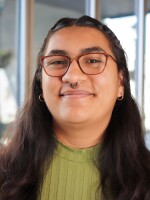Native American boarding schools left a legacy of trauma in Indigenous communities. Churches and the federal government used the schools to assimilate Native children, suppressing their language and culture.
To heal these wounds, the National Native American Boarding School Healing Coalition (NABS) is traveling the country talking to the survivors of these schools. The oral history project will visit Milwaukee June 23rd to 27th to collect stories from Wisconsin survivors.
WUWM reporter Jimmy Gutierrez and Eric Von Fellow Maria Peralta-Arellano spoke with oral history program manager Charlee Brissette learn more.
This conversation has been edited for length and clarity.
Maria Peralta-Arellano: Could you tell us what the introduction of the boarding schools looked like and how they altered Indigenous communities?
Charlee Brissette: I will have to say that the beginning of the boarding school era started in — in and before the 1880s. But it was around that time when Richard Henry Pratt, who is credited with starting Carlisle Industrial School in Pennsylvania — it wasn’t the earliest school, but it was one of the earliest schools that was used as a model to design the rest of the Native American boarding schools that were federally supported in the United States. You know, as we know, colonization has played a huge role in the determinants of health of our communities and Native American individuals. So every person has been impacted by the effects of not only colonization, but the Indian boarding school legacy.
Jimmy Gutierrez: Can we spend some more time with exactly what was the purpose behind these schools? Why were they built?
Brissette: So it'll kind of depend on which sources you're taking information from, but there were multiple reasons for these schools. And the biggest thing is to erase an entire race of people and to eradicate a culture and an entire group of people.
Sometimes we see it as our American Indian genocide. There’s also the aspect of the land grab — you know, by weakening communities, by separating families, separating and destroying family units, it made communities easier to target for land grab initiatives. It’s so multifaceted. It’s really unimaginable — the breadth of the effects of not just boarding schools, but boarding schools as part of a larger system to erase and eradicate people.
Peralta-Arellano: Why is it important to record and preserve those stories from the survivors themselves?
Brissette: The first thing that I will say is, because this is the true history — this is the truth coming directly from those that attended these institutions. And so we know it is the truth because it's exactly what has happened to them. And so we need to preserve these histories so that they don't get lost, so that they're not forgotten, and that they're recorded and preserved not only for their family's legacy and their own legacy, but for generations to come. There can be profound healing that comes from sharing one's story.
To participate in the Native American boarding school oral history project, you can sign up by calling (651) 650-4445, emailing OralHistoryProject@nabshc.org, or clicking here.






